| Occupy Bath | |
|---|---|
| Part of the "Occupy" protests | |
| Date | 30 October 2011 – 10 December 2011 |
| Location | |
| Caused by | Economic inequality, corporate influence over government, inter alia. |
| Methods | |
| Status | Ended |
Occupy Bath was a protest group against economic inequality that began initially with an encampment on 30 October 2011 in Queen Square, Bath, England. [1] The camp was dismantled on 10 December 2011. Occupy Bath described themselves as being "not all anti-capitalist" but rather "pro-economic fairness and pro-direct democracy". [2] The camp held daily meetings, described by the group as general assemblies, which were open to the general public [3]
Within days of setting up camp, Bath and North East Somerset Council stated that they wanted the camp gone by Remembrance Day or sooner, expressing concerns about the state of the grass and disruption to others wishing to use the space and threatening legal action if the camp were to continue past Remembrance Day. [4] [5] The Occupiers claimed shortly afterwards that the leave date of Remembrance Day was due to the original Facebook event requiring an end date, and that they would leave when they felt it was time to. [6]
Campaigners from the Occupy Bath camp attended a conference with representatives from other British Occupy camps at Occupy London on 19 November, based in the Bank of Ideas, a repossessed UBS bank building. [7]
By mid-late November, numbers on site had begun to decline, particularly overnight, [8] with approximately 10-15 people staying at the camp. [9] Towards the end of November, the Occupiers announced that they would be joining the union march during the strike on 30 November 2011, and invited marchers to visit the camp following the march, where there would be speakers, an attempt to explore common ground, and a big announcement. [2] [10] Occupiers spoke in front of the trade unionists in Victoria Park and announced the beginning of a new forum for Bath - the Bath People's Assembly - "an independent, democratic, non-affiliated body for discussion, debate and the formulation of ideas and proposals on local, national and global issues and policies". [8] [11] [12] [13] [14]
The Occupiers packed up the camp on 10 December 2011, stating that they wanted to focus on the Bath People's Assembly and on direct action in the area, stating "This is only the beginning". [15] [16] They claimed that up to 50 people had been camping in Queen Square at the height of the Occupation. Despite previous warnings from B&NES council, the Occupiers were not forced to move. [17] B&NES council said that they planned to send in teams to clean up Queen Square once the Occupiers have left.
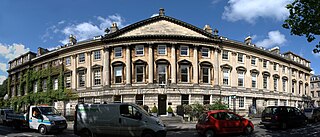
Queen Square is a square of Georgian houses in the city of Bath, England. Queen Square is the first element in "the most important architectural sequence in Bath", which includes the Circus and the Royal Crescent. All of the buildings which make up the square are Grade I listed.

Occupy Los Angeles is one of the many occupy movements in the United States, following the original Occupy Wall Street (OWS) protest. Participants of Occupy L.A. first met at Pershing Square on September 23, 2011. Activists came to consensus to occupy public space in solidarity with the growing movement. Occupiers first marched in Los Angeles on September 24, 2011. They next protested a fundraiser being held in Hollywood at the House of Blues for President Obama. Participants met at Pershing Square every subsequent night to plan out the logistics of an occupation set to begin on October 1, 2011. After debating potential locations around Los Angeles, people decided on the lawns around City Hall. Tents first manifested on October 1, 2011 on the grounds of Los Angeles City Hall.

Occupy Portland was a collaboration that began on October 6, 2011 in downtown Portland, Oregon as a protest and demonstration against economic inequality worldwide. It is inspired by the Occupy Wall Street movement that began in New York City on September 17, 2011.

Occupy Seattle was a series of demonstrations in Seattle, Washington, United States in 2011 and 2012, that formed part of the wider Occupy movement taking place in numerous U.S. and world cities at that time. The demonstrations were particularly focused on the city's downtown area including Westlake Park and Seattle City Hall; their stated aim was to oppose wealth inequality, perceived corporate greed, and corruption in the banking and economic systems of the United States.
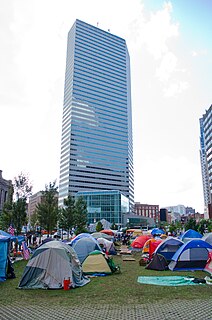
Occupy Boston was a collective of protesters that settled on September 30, 2011 in Boston, Massachusetts, on Dewey Square in the Financial District opposite the Federal Reserve Bank of Boston. It is related to the Occupy Wall Street movement that began in New York City on September 17, 2011.

The Occupy movement was an international left-wing populist socio-political movement that expressed opposition to social and economic inequality and to the lack of "real democracy" around the world. It aimed primarily to advance social and economic justice and new forms of democracy. The movement has had many different scopes, since local groups often had different focuses, but its prime concerns included how large corporations control the world in a way that disproportionately benefits a minority, undermines democracy and causes instability.

Occupy Buffalo was a collaboration that included a peaceful protest and demonstrations which began on October 1, 2011, in Buffalo, New York, in Niagara Square, the nexus of downtown Buffalo opposite the Buffalo City Hall. It is related to the Occupy Wall Street movement that began in New York City on September 17, and called for economic equity, accountability among politicians and ending lobbyist influence of politicians. Protesters camped overnight in Niagara Square as part of the demonstration.
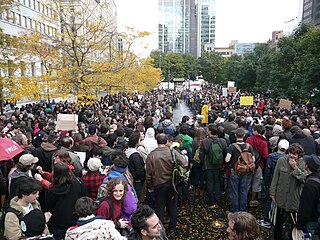
Occupy Canada was a collective of peaceful protests and demonstrations that were part of the larger Occupy Together movement which first manifested in the financial district of New York City with Occupy Wall Street, and subsequently spread to over 900 cities around the world.

Occupy London was a movement for social justice in London, England, and part of the international Occupy movement. While some media described it as an "anti-capitalist" movement, in the statement written and endorsed by consensus by the Occupy assembly in the first two days of the occupation, occupiers defined themselves as a movement working to create alternatives to an "unjust and undemocratic" system. A second statement endorsed the following day called for "real global democracy". Due to a pre-emptive injunction, the protesters were prevented from their original aim to camp outside the London Stock Exchange. A camp was set up nearby next to St Paul's Cathedral. On 18 January 2012, Mr Justice Lindblom granted an injunction against continuation of the protest but the protesters remained in place pending an appeal. The appeal was refused on 22 February, and just past midnight on 28 February, bailiffs supported by City of London police began to remove the tents.
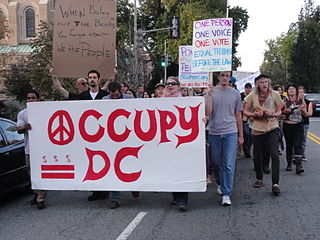
Occupy D.C. was an occupation of public space in Washington, D.C. based at McPherson Square and connected to the Occupy movements that sprung up across the United States in Fall 2011. The group had been demonstrating in McPherson Square since October 1, 2011, and in Freedom Plaza since October 6. Despite crackdowns on other Occupy projects across the country, federal authorities claimed on November 15 that they have no plans to clear McPherson Square Park. The National Park Service decided against eviction after meeting with activists and discussing health and safety conditions.

Occupy Melbourne was a social movement which took place from late 2011 to mid 2012 in Melbourne, Australia as part of the global Occupy movement. Participants expressed grievances concerning economic inequality, social injustice, corruption in the financial sector, corporate greed and the influence of companies and lobbyists on government. Protests began on 15 October 2011 in City Square with a 6-day-long protest encampment, from which people were forcibly evicted by Victoria Police at the request of the City of Melbourne CEO on 21 October 2011. From 2 November 2011, Occupy set up camp in Treasury Gardens before being moved on from that location in December. A significantly diminished number of protesters set up camp at Father Bob's church at his invitation until his retirement in January 2012. Physical manifestations of the movement had largely dissipated by mid-2012 though it adopted a strategy of decentralisation and became influential in the creation of new community networks, affinity groups and collectives.

Occupy Movement protests took place in New Zealand, beginning on 15 October 2011 with the Occupation of Auckland. Occupy protests took place in Auckland, New Plymouth, Wellington, Lower Hutt, Christchurch, Dunedin, and Invercargill.

The Occupy movement began in the United States initially with the Occupy Wall Street protests in New York City, but spread to many other cities, both in the United States and worldwide. This list article is an alphabetical, non-chronological summary of Occupy events that have occurred in cities in the United States.
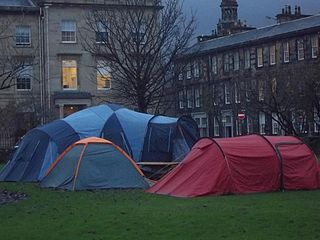
Occupy Glasgow was a protest in Glasgow, Scotland, and an offshoot of the Occupy movement. The protest started on 15 October 2011 opposite the City Chambers in George Square, but due to possible conflict with Remembrance Day events, Glasgow City Council granted an eviction warrant, in force from 7 November, and protesting was moved to Kelvingrove Park in agreement with the council.
Occupy Windsor was an Occupy movement encampment in David Croll Park, Windsor, Ontario, Canada. The protest ended and all protesters evacuated the area on December 12, 2011 with promises to return to the park to reseed areas damaged by the camp.
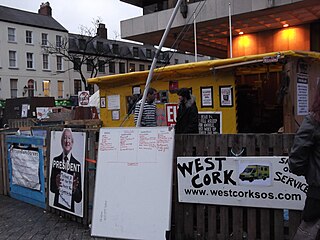
Occupy Dame Street (ODS) or Occupy Dublin was a peaceful protest and demonstration against economic inequality, social injustice and corporate greed taking place outside the Central Bank of Ireland plaza on Dame Street in Dublin, beside the Temple Bar area of the city. Part of the global Occupy movement, it took its name from the Occupy Wall Street demonstration in New York City's Wall Street financial district. Occupy Dame Street had four requests: the withdrawal of the EU/IMF from Ireland, an end to public ownership of private debt, the return to public ownership of Ireland's privatised oil and gas reserves, and the implementation of what the movement describes as "real participatory democracy". The national police force, Garda Síochána, dismantled their camp during a late-night raid on 8 March 2012. The protesters vowed to fight on. Some were never heard of again, while others found other channels of protest. The most detailed account and analysis of events was written by Helena Sheehan.

Occupy Sydney was a social movement and protest as part of the global Occupy movements, in Sydney, Australia. The occupation began on 15 October 2011 outside the Reserve Bank of Australia in Martin Place. The Martin Place occupation was first evicted by NSW Police on 23 October 2011. This eviction and later police action was named Operation Goulding. Another eviction attempt occurred on 2 February 2012. The protest site was removed five times in early July 2013, only to re-establish itself each time within hours.

Occupy Redwood City was a collaboration that began with peaceful protests, demonstrations, and general assemblies in front of the historic San Mateo County Courthouse in Redwood City, California. The demonstration was inspired by Occupy Wall Street and is part of the larger "Occupy" protest movement.

Occupy Ottawa was a mostly peaceful, leaderless, grassroots and democratic protest movement that began on Confederation Park in Ottawa, Ontario, on October 15, 2011. The movement's slogan "Home of the global revolution in Ottawa" refers to its inspiration by, and association with, the Arab Spring, Occupy Wall Street and the global Occupy Movement, which protests growing economic inequality, corporate greed, and the influence of corporations and lobbyists on electoral politics and government. Occupy Ottawa seeks global economic, social, political and environmental justice.